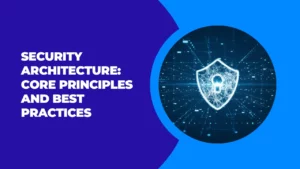Physical Address
304 North Cardinal St.
Dorchester Center, MA 02124
Physical Address
304 North Cardinal St.
Dorchester Center, MA 02124

In today’s digital age, data breaches and cyber-attacks are becoming more common than ever. As businesses continue to rely heavily on technology, it becomes increasingly important to establish a robust security architecture that can protect sensitive information from potential threats.
Security architecture refers to the design and structure of an organization’s security measures. It involves defining policies, processes, and systems to ensure the confidentiality, integrity, and availability of information assets.
In this blog post, we will explore the core principles of security architecture along with best practices that can be implemented to safeguard your organization. We will also highlight some key security architecture frameworks that you can use as a reference point.
Additionally, we will discuss the benefits of implementing a strong security architecture and how it contributes to risk management. Lastly, we will talk about why continuous learning and training are crucial for staying ahead in the world of cybersecurity.
Managed WordPress hosting ensures a secure and efficient website with automated updates, backups, and enhanced security features, reducing the workload for site administrators.

A systematic approach to designing and implementing security controls, security architecture involves assessing vulnerabilities and risks to develop a robust framework.
TOGAF and SABSA provide guidance for creating effective architectures, and a strong security architecture is crucial for an organization’s risk management strategy, protecting sensitive data and mitigating potential threats.
Security architecture refers to the design and structure of a security system. It encompasses access management, encryption, and authentication, among other elements.
Security architects play a crucial role in developing and implementing effective security architectures that align with an organization’s goals and consider its business needs, legislative landscape, and latest security standards.
Security architecture plays a crucial role in cybersecurity by protecting against cyber threats and breaches. It provides a framework for implementing security measures and managing security operations.
A well-designed security architecture helps organizations create a risk-free environment, ensuring that all security services and controls work together to safeguard sensitive information and comply with regulations. By incorporating executable strategies, organizations can enhance their security context and keep their business operations secure.
Implementing a layered defense is crucial in security architecture to protect against different threats. Granting the least privilege ensures authorized access for users, minimizing the risk of unauthorized activity.
Deploying defense in depth involves multiple security measures at different levels, creating a robust architecture. These principles strengthen security posture and help organizations manage potential threats effectively.
Implementing security controls at different network layers creates a layered defense approach. Each layer adds an extra level of protection, making it challenging for attackers to breach the system.
Examples of such controls include firewalls, intrusion detection systems, and secure access management.
The principle of least privilege ensures that users are only given the minimum privileges necessary for their tasks. This reduces the risk of unauthorized access and accidental data leakage.
Strong access control measures and regular review of user privileges are essential for implementing this principle.
Implementing the defense-in-depth principle involves deploying multiple layers of security controls throughout the organization’s infrastructure. This includes physical security measures, network security, and data encryption.
By utilizing a multi-layered approach to security, organizations can mitigate potential threats and minimize their impact.
Regularly updating and patching systems is crucial to address known vulnerabilities while implementing strong access control measures such as multi-factor authentication and granular access permissions to ensure only authorized individuals can access sensitive data.
By adhering to these best practices, organizations can enhance their security architecture and protect against potential cyber threats.
Regularly updating and patching systems is crucial for protecting against known vulnerabilities. By applying security patches and software updates, the system remains up to date with the latest security fixes.
This regular patching practice is an essential best practice for maintaining a secure environment.
Implementing strong access control measures, such as multi-factor authentication and tokens, helps prevent unauthorized access and protects sensitive data.
Strict access controls ensure that only authorized individuals can access information. Implementing access management solutions is crucial for safeguarding against data theft and unauthorized access.
Continuous monitoring allows for real-time threat detection and response. Auditing ensures that security policies and procedures are being followed. Implementing continuous monitoring and auditing can help organizations meet compliance requirements.
Regularly reviewing and analyzing monitoring and audit data can help identify areas for improvement in the security architecture. Tools such as security information and event management (SIEM) systems can assist with continuous monitoring and auditing efforts.
Integrating security into the design phase is crucial to ensure a robust system or application. By including security requirements in the initial design documents and reviewing them throughout development, organizations can consistently apply security measures.
Following industry-standard best practices, regular vulnerability testing and threat modeling further enhance security. Incorporating security in the design phase saves time and money by preventing costly security issues later in the development process.
Highlighting Key Security Architecture Frameworks, we have the Information Assurance Framework (IAF), which provides guidelines for designing secure systems. The Open Group Architecture Framework (TOGAF) offers a structured approach to enterprise architecture.
The Zachman Framework organizes architectural artifacts in a matrix structure. SABSA is a business-driven framework that aligns security with business objectives. Lastly, the NIST Cybersecurity Framework improves risk management and resilience in organizations.
The TOGAF Framework is an essential tool for creating effective security architecture. It consists of four main components: the Architecture Development Method, Enterprise Continuum, Architecture Content Framework, and Architecture Capability Framework.
By aligning security architecture with business goals and objectives, organizations can implement best practices such as documentation, stakeholder communication, and risk management. Successful case studies demonstrate the value of implementing security architecture using the TOGAF Framework.
SABSA framework is a business-driven security architecture method that aligns security with business objectives. It consists of six layers: Business, Information, Application, Technology, Physical, and People.
Implementing the SABSA framework in your organization brings benefits such as improved security architecture planning and successful implementation in real-world scenarios. Best practices include considering the context, potential partners, and executable strategies for keeping your organization safe.
The OSA (Open Security Architecture) Framework plays a crucial role in security architecture. It encompasses core principles such as defense-in-depth, least privilege, and separation of duties.
To implement effective security architecture, regular risk assessments, and strong access controls are essential. Compliance frameworks like ISO 27001 and NIST provide guidance, while ongoing monitoring and testing ensure effectiveness.
Implementing strong security architecture offers a range of benefits. It protects organizations against cyber threats and data breaches, ensuring compliance with industry regulations.
Effective security architecture improves business operations, enhances reputation, and saves costs associated with security incidents. By implementing executable strategies and utilizing NLP terms such as zero trust, malware, and cloud computing, organizations can create a robust security architecture that keeps their sensitive information safe.
A robust security architecture greatly reduces the risk of security breaches by implementing core principles such as risk assessment, defense in depth, and least privilege.
Best practices like regular vulnerability assessments, network segmentation, and employee training further enhance security. An adaptable security architecture can effectively counter evolving threats and help prevent costly data breaches, saving businesses time and money in the long run.
Implementing a proactive security approach is crucial to prevent potential breaches and reduce costs. By adhering to core principles like confidentiality, integrity, and availability, organizations can establish a robust security architecture.
Best practices such as risk assessments and vulnerability management further enhance security efforts. Security frameworks like NIST or ISO provide guidance, resulting in cost-efficiency, increased customer trust, and reduced legal and regulatory risks.
Rapid identification and containment of threats, followed by a comprehensive investigation to determine the root cause, is crucial in mitigating disciplinary actions post-breach. Remediation measures must be implemented to address the issue and prevent future breaches.
Timely and transparent communication with stakeholders and ongoing evaluation of security architecture ensure effective mitigation. Continuous improvement is key in combating malicious actors and safeguarding organizational safety.
Security architecture plays a key role in risk management by identifying and mitigating potential security threats. It helps protect sensitive data through robust security controls.
By aligning with the overall risk management strategy, security architecture ensures preparedness for breaches. Strong frameworks like TOGAF and SABSA provide comprehensive security management structures.
Effective security architecture plays a crucial role in identifying vulnerabilities and potential threats to an organization’s information security. By analyzing network security and access management, security architects can pinpoint potential weaknesses and assess and manage risks to systems and data.
Frameworks like TOGAF and SABSA provide guidelines for addressing and mitigating risks while adhering to the latest security standards and best practices. Ensuring a risk-free environment is essential for organizations to protect their assets from malicious actors and maintain a secure and reliable infrastructure.
Implementing a strong security architecture plays a crucial role in mitigating risks by implementing robust security measures such as encryption, authentication, and access control.
It enables organizations to effectively manage and respond to potential threats while providing a structured approach to risk management. Continuous monitoring and evaluation help identify and address emerging risks.
Continuous learning and training play a crucial role in security architecture. By staying updated with the latest standards and best practices, security architects can develop robust security architectures that effectively address evolving cyber threats.
Regular upgrades in knowledge enable them to design and implement effective security measures.
Regular upgrades and updates in knowledge enable security architects to stay ahead of emerging threats and vulnerabilities, ensuring robust security architectures. With cyber threats constantly evolving, security architects must continuously update their knowledge to incorporate the latest security services and technologies.
Staying informed about the latest security standards and best practices enhances the effectiveness of security architectures, allowing security architects to address new and evolving security challenges.
Training programs and courses equip security architects with the necessary skills to design and implement effective security architectures, keeping them updated with the latest trends and technologies.
By developing a holistic understanding of security management and risk mitigation, architects can align their architectures with business needs. Continuous training provides insights into best practices and industry standards for security architecture.
Security architecture reinforces enterprise information security by implementing a robust system that protects sensitive data, prevents unauthorized access, and seamlessly integrates security measures into business operations.
It also ensures compliance with data protection regulations like GDPR and provides a comprehensive approach to data security and protection.
In conclusion, implementing a strong security architecture is crucial for safeguarding sensitive information and protecting against cyber threats. By following core principles such as layered defense, least privilege, and defense in depth, organizations can establish a robust security framework.
Incorporating best practices like regularly updating systems, implementing strong access controls, and employing continuous monitoring further enhances security measures. Utilizing key security architecture frameworks such as TOGAF, SABSA, and OSA provides a structured approach to design and implementation.
The benefits of implementing a strong security architecture include fewer security breaches, cost-efficiency, and mitigation of disciplinary actions post-breach. Security architecture also plays a vital role in risk management by identifying and mitigating risks effectively.
Continuous learning and training are essential to stay updated with the latest threats and technologies. Overall, a well-designed security architecture reinforces enterprise information security and promotes a secure digital environment.